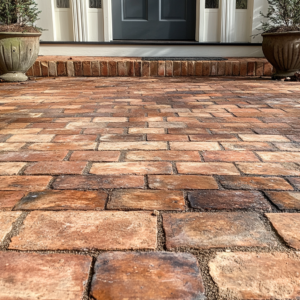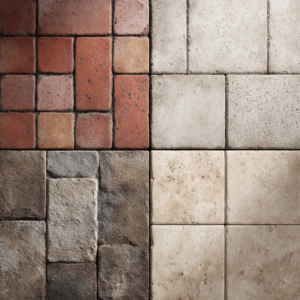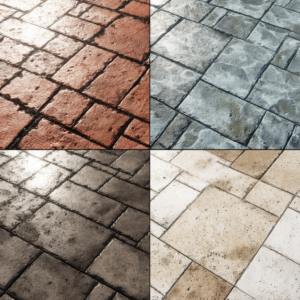Travertine pavers add timeless elegance and natural beauty to outdoor spaces. However, like any other surface, they require regular cleaning and maintenance to retain their charm. In this article, we will provide you with a step-by-step guide on how to clean travertine pavers.
When it comes to travertine, proper cleaning practices are extremely important, to ensure their longevity and preserve their pristine condition. Whether you’re dealing with dirt, stains, or general wear and tear, following our instructions will help you restore the natural luster of your travertine pavers.

Jump to:
How to clean travertine pavers: pre-cleaning preparation
First things first, you’ll want to gather all the necessary supplies.
You will need a broom with soft bristles to avoid scratching the travertine pavers, a soft-bristle brush for more focused cleaning, a mop for larger areas, a pH-neutral stone designed explicitly for travertine, a bucket to hold the cleaning solution, clean water for rinsing, and a microfiber cloth or towel for drying.
Before you start cleaning, it’s essential to clear the area of any furniture, planters, or objects that might obstruct your access to the entire surface. This step ensures that you can thoroughly clean every nook and cranny of the travertine pavers without any hindrances.
Once the area is clear, grab your broom and start sweeping away loose dirt, leaves, or any other debris that has accumulated on the surface of the travertine pavers.
Sweeping is an important initial step as it helps remove larger particles that could potentially scratch the stone during the cleaning process. Make sure to be thorough and pay attention to any corners or crevices where debris might be trapped.
While sweeping, be gentle to avoid unnecessary pressure that could cause scratches. It’s advisable to use a broom with soft bristles specifically designed for outdoor surfaces. If there are any stubborn stains or debris, you can use a soft-bristle brush to give them a gentle scrub.
Cleaning process of travertine pavers
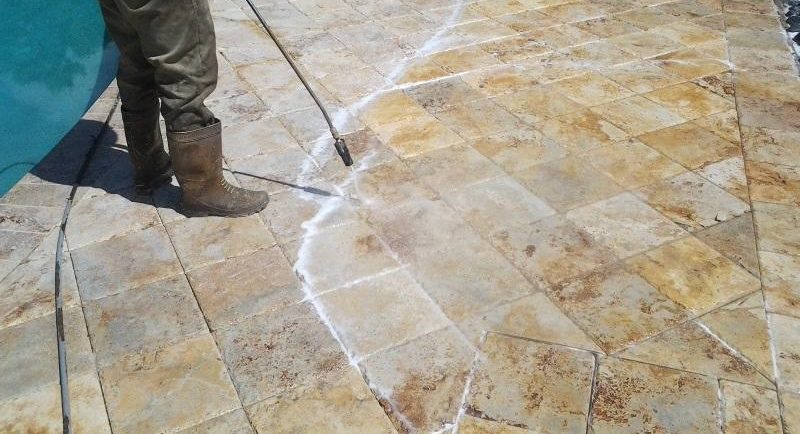
We highly recommend the use of specialized stone cleaners for the travertine cleaning process. By doing that, you need fewer materials, things get a lot simpler, and you don’t risk damaging your travertine pavers with the wrong home-mixed solution.
Before applying the stone cleaner, carefully read and follow the instructions provided on the packaging. Most stone cleaners require dilution with water to achieve the appropriate concentration. It’s crucial to dilute the cleaner properly to ensure effective cleaning without causing any damage to the travertine pavers.
Once the cleaner is properly diluted, pour it onto the travertine pavers. Start at one end and work your way across the entire surface. Use a mop or a soft-bristle brush to distribute the cleaner evenly, making sure to cover all areas. This step allows the stone cleaner to penetrate the pores of the travertine, effectively loosening dirt, grime, and stains.
With the stone cleaner applied, it’s time to gently scrub the travertine pavers. Use a soft-bristle brush or a mop with gentle pressure, employing circular motions to agitate the cleaner and lift away any embedded dirt or stains. Pay extra attention to areas that are visibly stained or heavily soiled.
After scrubbing, rinse the travertine pavers to remove any traces of the cleaner. Use clean water and ensure that all areas are rinsed well. Take your time to thoroughly rinse the entire area, paying attention to any crevices or corners where cleaner residue may accumulate.
Once the rinsing is complete, it’s time to dry the travertine pavers. Using a clean microfiber cloth or towel, carefully dry the surface, ensuring that no moisture remains. Be thorough in drying the entire surface, including any cracks or crevices, to avoid the potential for water damage or discoloration.
Removing stains from travertine pavers
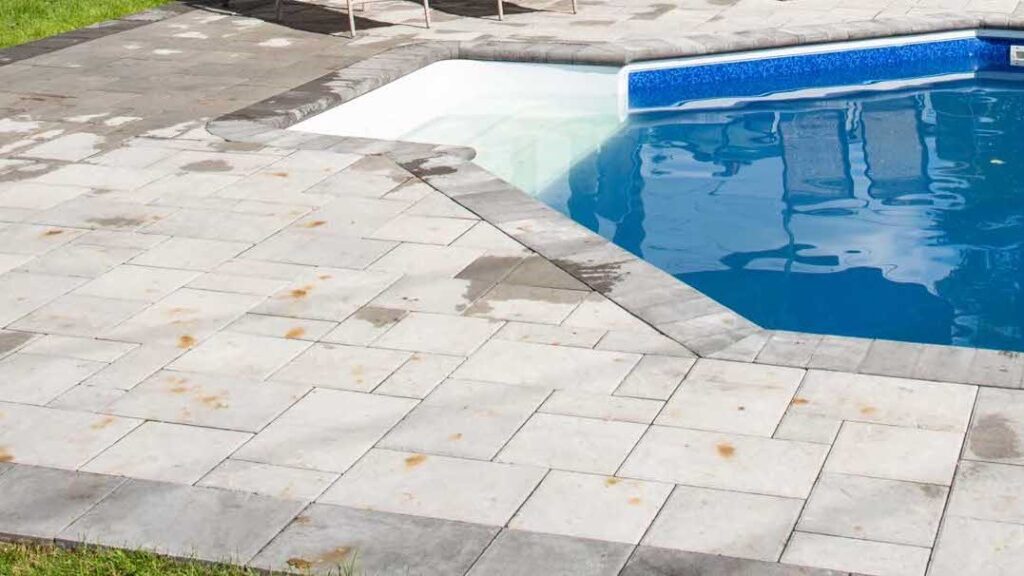
Stains can be a common and frustrating issue on travertine pavers. Ideally, your travertine paver installation should be sealed to avoid any stains and help future maintenance practices.
To successfully remove stains, it is crucial to identify the stain type accurately and apply the appropriate cleaning method. By understanding different stain types and their corresponding treatments, you can effectively improve stain removal results.
Oil stains
If you notice oil-based stains on your travertine pavers, such as grease or cooking oil, a poultice can be an effective solution.
Start by mixing a powdered stain remover with water to create a thick paste. Apply the poultice directly to the stain, ensuring it completely covers the affected area. Cover the poultice with plastic wrap to prevent it from drying out.
Leave it overnight to allow the paste to draw out the oil from the pavers. The next day, gently remove the poultice and rinse the area thoroughly with water.
Organic stains
Organic stains, including those caused by leaves, berries, or other natural materials, can be treated with a mild detergent solution.
Create a mixture of mild detergent and water, making sure it is properly diluted. Apply the solution to the stained area, allowing it to sit for a few minutes to break down the organic matter. Next, use a soft-bristle brush to gently scrub the stained surface.
Be careful not to apply excessive force that could damage the pavers. Finally, rinse the area thoroughly with water to remove any residue.
Rust stains
Rust stains can present a more challenging problem. It is advisable to consult with a professional stone cleaner who has experience in handling rust stains.
Still, you may consider using a rust remover specifically formulated for natural stone surfaces. When using a rust remover, it is vital to carefully follow the instructions provided by the manufacturer. Improper use can result in damage to the pavers.
Always conduct a patch test on a small, inconspicuous area of the travertine to ensure compatibility and avoid any adverse reactions.
Professional stone cleaning

Maintaining the natural beauty of your travertine pavers requires regular cleaning and care. By following the step-by-step guide provided in this article, you can effectively clean the pavers, remove stains, and protect them for years to come.
However, the best course of action, as always, is to hire professional hardscape contractors to perform that cleaning for you. Nothing can substitute experience and dedicated time, so keep that in mind if you realize your travertine installation needs a deep cleaning.
We here at JS Brick have been providing that kind of job for 23 years, so we know the importance of knowing exactly what you’re doing every step of the way, so you don’t end up damaging your pavers.
If you are around Sarasota County, FL, why not give us a call to help you? You can get in contact any time for a free estimate on our services.

